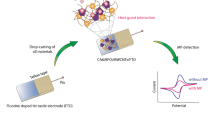Abstract
A bioelectronic sensor for triethylamine (TEA) was developed with a flavin-containing monooxygenase type 3 (FMO-3). The TEA biosensor consisted of a Clark-type dissolved-oxygen electrode and an FMO-3 immobilized membrane. The FMO-3 solution was mixed with a poly(vinyl alcohol) containing stilbazolium groups (PVA-SbQ), coated on to the dialysis membrane, and the membrane was irradiated with a fluorescent light to immobilize the enzyme. In order to amplify the biosensor output, a substrate regeneration cycle, obtained by coupling the monooxygenase with l-ascorbic acid (AsA) as reducing reagent system, was applied. The effect of pH on the determination of TEA was studied. The maximum response was achieved at pH >9.0. A drop of the phosphate buffer solution with the AsA was put on the sensing area of the oxygen electrode, and the FMO-3 immobilized membrane was placed on the oxygen electrode and covered with a supporting Nylon mesh net which was secured with a silicone O-ring. A measurement system for TEA solution was constructed using the FMO-3 biosensor, a personal computer, a computer-controlled potentiostat, and an A/D converter. The FMO-3 biosensor was used to measure TEA solution from 0.5 to 4.0 mmol L−1 with 10.0 mmol L−1 AsA. The biosensor also had good reproducibility, for example a 6.31% coefficient of variation for five measurements, and the output current was maintained over a few hours. In order to improve the selectivity of the TEA biosensor, three type of biosensor with FMO isomer types 1, 3, and 5 were constructed and used to measure nitrogen and sulfur compounds. The outputs of the isomer biosensors indicated individual patterns for each sample solution. The selectivity of TEA biosensor would be improved, and determination of sulfur and nitrogen compounds would be possible, by using the different output of biosensors prepared from different FMO isomers.







Similar content being viewed by others
References
International Programme on Chemical Safety (2002) International Chemical Safety Cards (ICSCs), 0203 (triethylamine)
US Department of Health and Human Services (1993) Hazardous Substances Data Bank, National Toxicology Information Program, National Library of Medicine, Bethesda, MD
Budavari S (ed) (1989) The Merck index, an encyclopedia of chemicals, drugs, and biologicals, 11th edn. Merck, Rahway, NJ
Bailescu F, Cosofret VV (1978) Applications of ion-selective membrane electrodes in organic analysis. Ellis Horwood, Chichester
Morf WE, Pungor E, Incsedy SW (eds) (1981) The principles of ion-selective electrodes and membrane transport. Elsevier, Amsterdam, pp 402–406
Meyerhoff ME (1980) Anal Chem 52:1532–1534
Fraticelli YM, Meyerhoff ME (1981) Anal Chem 53:992–997
Buhlmann P, Pretsch E, Bakker E (1998) Chem Rev 98:1593–1687
West SJ, Ozawa S, Seiler K, Tan SSS, Simon W (1992) Anal Chem 64:533–540
Morales-Bahnik A, Czolk R, Ache HJ (1994) Sens Actuators B 19:493–494
Hidaka H, Hartman B, Udenfriend S (1971) Arch Biochem Biophys 147:805–809
McCauley R, Raeker E (1973) Mol Cell Biol 1:73–81
Aoki S, Manabe T, Okuyama T (1977) J Biochem 82:1533–1539
Lang DH, Yeung CK, Peter RM, Ibarra C, Gasser R, Itagaki K, Philpot RM, Rettie AE (1998) Biochem Pharmacol 56:1005–1012
Haining RL, Hunter AP, Sadeque AJM, Philpot RM, Rettie AE (1997) Drug Metab Dispos 25:790–797
Mitsubayashi K, Yokoyama K, Takeuchi T, Karube I (1994) Anal Chem 66:3297–3302
Mitsubayashi K, Hashimoto Y (2000) Electrochemistry 68:901–903
Mitsubayashi K, Amagai H, Watanabe H, Nakayama Y (2005) Sens Actuators B 95:303–308
Minamide T, Mitsubayashi K, Jaffrezic-Renault N, Hibi K, Endo H, Saito H (2005) Analyst 130:1490–1494
Minamide T, Mitsubayashi K, Saito H (2005) Sens Actuators B 108(1/2):639–645
Mitsubayashi K, Hashimoto Y (2002) Sens Actuators B 83:35–40
Ichimura K (1984) J Polym Sci 22:2817–2828
Mitsubayashi K, Matsunaga H, Nishio G, Toda S, Nakanishi Y (2005) Biosens Bioelectron 20:1573–1579
Parliament TH, Kolor MG, Rizzo DJ (1982) J Agric Food Chem 30:1006–1008
Acknowledgement
This study was supported in part by JSPS (Japan Society for the Promotion of Science) Grants-in-Aid for Science Research System.
Author information
Authors and Affiliations
Corresponding author
Rights and permissions
About this article
Cite this article
Saito, H., Shirai, T., Kudo, H. et al. Electrochemical sensor with flavin-containing monooxygenase for triethylamine solution. Anal Bioanal Chem 391, 1263–1268 (2008). https://doi.org/10.1007/s00216-007-1806-x
Received:
Revised:
Accepted:
Published:
Issue Date:
DOI: https://doi.org/10.1007/s00216-007-1806-x




